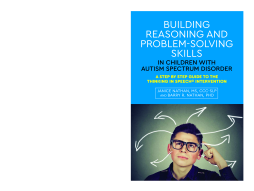
BOOK
Building Reasoning and Problem-Solving Skills in Children with Autism Spectrum Disorder
(2018)
Additional Information
Book Details
Abstract
Teaching children with Autism Spectrum Disorder (ASD) to develop the 'inner voice' needed to solve problems, this book's innovative approach will help children reach logical and appropriate solutions to everyday problems.
This book shows students and professionals how to formally teach key skills for reasoning and problem-solving that aren't usually explicitly taught, such as planning, pausing and reflecting and increasing emotional regulation. Focusing on the 'inner voice' - the dialogue that goes on inside our heads during every day routines - the authors explain how to help children with ASD solve problems independently.
The book also shows how children can learn to cope with feelings of stress when confronted with difficult situations, whether getting stuck on homework, making mistakes, choosing options, following procedures that are perceived to be arbitrary, or everyday social situations. Examples of implementing this new approach in different situations are given to show the many ways of teaching these cognitive skills to children with autism.
Janice Nathan, MS, CCC-SLP lives in Pittsburgh, Pennsylvania and is a certified speech-language pathologist and owner of Nathan Speech Services. She works with children and adults diagnosed with Autism Spectrum Disorder providing individual speech and language therapy.
Barry Nathan, PhD is an organizational psychologist and president of Leader Business Coaching. His research includes cognitive processing in performance evaluations, and using measures of executive functions to predict organizational performance.
This text is a model of Janice Nathan's own "inner speech"- how she integrates background research with her clinical experience to develop thinking and problem-solving skills in the modalities of spoken and written language with verbal children and adults with ASD. It is a valuable resource for any speech-language pathologist working with this population.
Diane L. Williams, Ph.D.CCC-SLP, author of 'Developmental Language Disorders: Language, Learning, and the Brain'
Table of Contents
| Section Title | Page | Action | Price |
|---|---|---|---|
| Building Reasoning and Problem-Solving Skills in Children with Autism Spectrum Disorder: A Step by Step Guide to the Thinking In Speech® Intervention by Janice Nathan, MS, CCC-SLP and Barry Nathan, PhD | 3 | ||
| Preface: Growing Up in a Family with Autism | 9 | ||
| Part I: Being on the Autism Spectrum | 13 | ||
| 1. Understanding Autism Spectrum Disorders | 15 | ||
| Part II: Autism as a Language and Executive Functioning Disorder | 23 | ||
| 2. About the Brain: Neuroscience for Understanding Autism | 25 | ||
| 3. Executive Functioning in Children with ASD | 33 | ||
| 4. Impulse Control and Emotion Regulation | 41 | ||
| 5. Implicit Learning | 51 | ||
| 6. The Thinking in Speech Model of Reasoning and Problem-Solving | 55 | ||
| Part III: Developing Inner Speech for Problem-Solving and Social Interactions | 69 | ||
| 7. Setting the Stage for the Thinking in Speech Intervention | 71 | ||
| 8. Developing Mental State and Emotions Vocabulary | 83 | ||
| 9. Vocabulary Development for Higher-Level Use of Language for Problem-Solving | 93 | ||
| 10. Answering Questions Logically | 101 | ||
| 11. Mental Flexibility to Generate Multiple Solutions | 109 | ||
| 12. Developing Theory of Mind | 115 | ||
| 13. Teaching “Chit-Chat” | 119 | ||
| Part IV: Literacy Development | 127 | ||
| 14. Developing Emerging Literacy Skills | 129 | ||
| 15. Understanding and Reading Textbooks | 141 | ||
| 16. Note Taking, Teaching Time and Assisting with Arithmetic | 155 | ||
| Part V: Final Thoughts | 165 | ||
| 17. Reminders When Implementing Thinking in Speech | 167 | ||
| References | 173 | ||
| Subject Index | 181 | ||
| Author Index | 186 | ||
| Blank Page |
